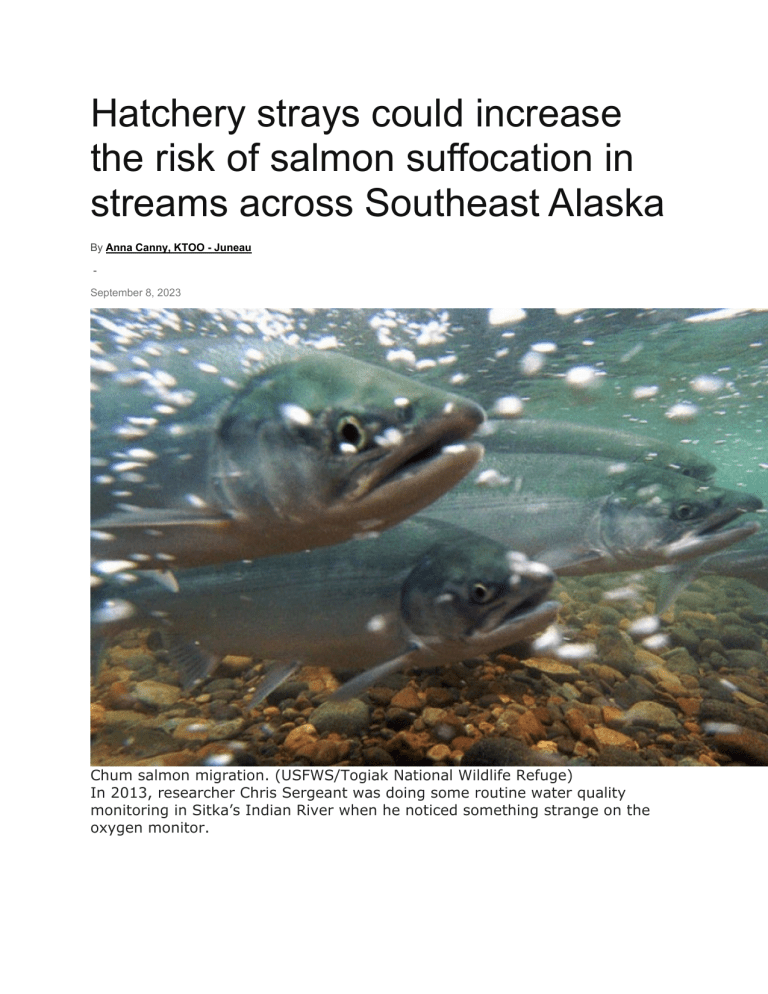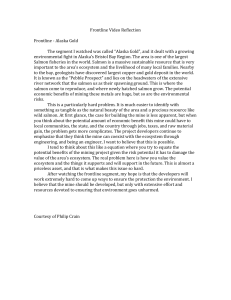
Hatchery strays could increase the risk of salmon suffocation in streams across Southeast Alaska By Anna Canny, KTOO - Juneau September 8, 2023 Chum salmon migration. (USFWS/Togiak National Wildlife Refuge) In 2013, researcher Chris Sergeant was doing some routine water quality monitoring in Sitka’s Indian River when he noticed something strange on the oxygen monitor. “It was getting close to zero — really, really low,” Sergeant said. “And there were fish dying off. Juvenile coho and cutthroat trout. And a high percentage of the adult salmon were hatchery strays.” The stream was choked, filled with too many fish that couldn’t get enough oxygen. Salmon die-offs like that have been documented for at least a century, but their causes have not been well-understood. Now, a new study by Sergeant and his research team suggests that a booming population of hatchery-raised salmon in Southeast Alaska could put pressure on thousands of miles of salmon streams that are already vulnerable due to climate change. “We have too many salmon breathing too much oxygen,” Sergeant said. “It’s an unnaturally high population.” The water in rivers and streams has dissolved oxygen in it, which salmon and other fish breathe through their gills. When those fish can’t get enough oxygen, they can suffocate. In less extreme cases, low oxygen can slow salmon down on their strenuous trip upstream. “They may not make those spawning grounds in time or have enough time to spawn,” Sergeant said. “So there’s a lot of really subtle effects in addition to just massive die-offs.” Scientists have long warned that hatchery salmon can compete with wild fish for resources, including oxygen. And for more than half a century, hatchery production across Alaska has boomed, especially for pink and chum salmon. Those populations are supposed to return to their hatchery when they spawn, but they commonly stray into wild streams. According to the study’s authors, that could put wild salmon — including more desirable species like chinook, coho and sockeye — at a higher risk of smothering. The study maps more than 10,000 miles of wild salmon habitat in Southeast Alaska that are close to hatchery release sites, creating the potential for overcrowded streams. And salmon’s risk of hypoxia is made worse by human-caused climate change. Rising water temperatures across the region have been linked to salmon dieoffs in recent years, and warm water holds less oxygen. When hot temperatures are accompanied by drought, salmon streams are even more primed for hypoxia. That’s because an ideal salmon habitat is rough and fast-flowing. That kind of water is oxygen rich. “The more the water tumbles and foams, like a rapid, the more opportunity it has to exchange with the atmosphere,” Sergeant said. “That tumbling motion of the water is basically injecting oxygen.” Climate change is expected to bring more precipitation to Southeast Alaska overall, but the region still faces a growing risk of drought. Extreme rainstorms are likely to be punctuated by longer dry periods, especially in summer. And declining snowpack in the mountains could also cause drought. According to Ryan Bellmore, a U.S. Forest Service researcher who co-authored the study, snowpack is like a bank account for the watershed. “And we’re more likely to go into the red,” Bellmore said. Water is saved in the high mountains in the winter and then melts gradually throughout spring and summer, feeding the rivers and streams. Without it, salmon streams could dry up and slow down in the summer heat, which could lead to low oxygen levels. And as climate change puts pressure on Southeast Alaskan watersheds, cramped conditions may continue to strangle wild salmon.





